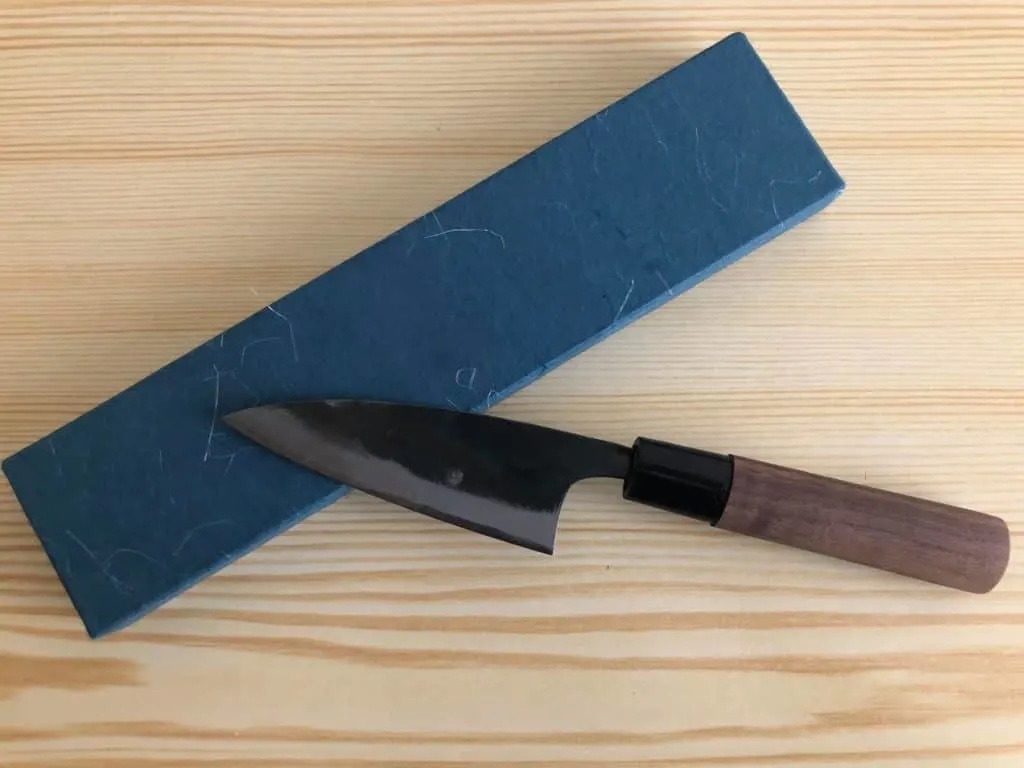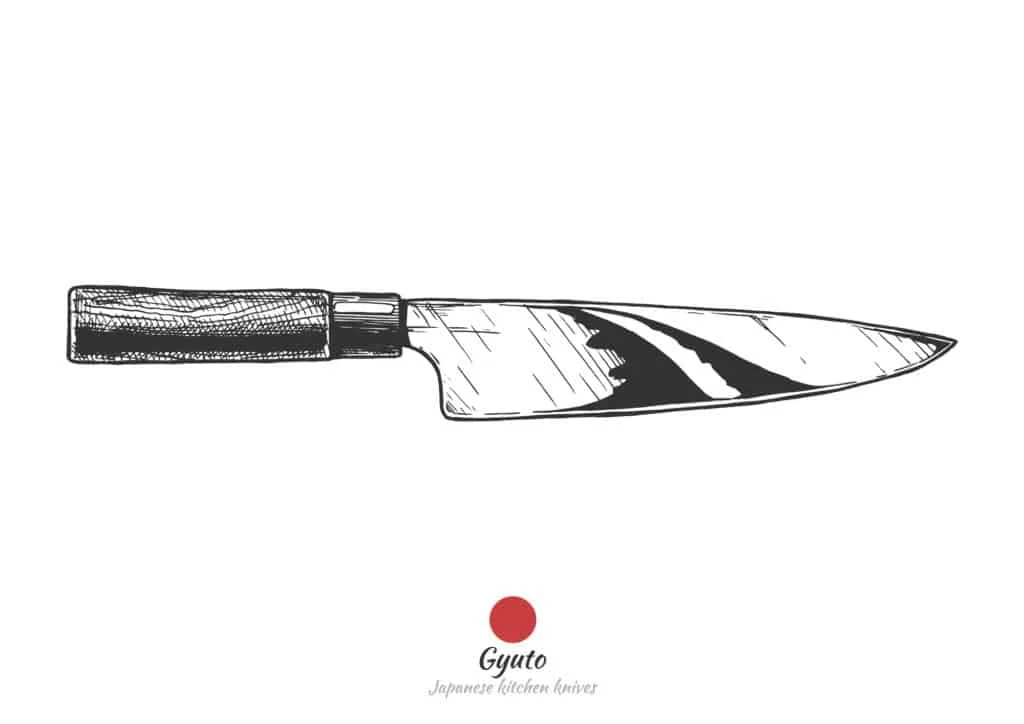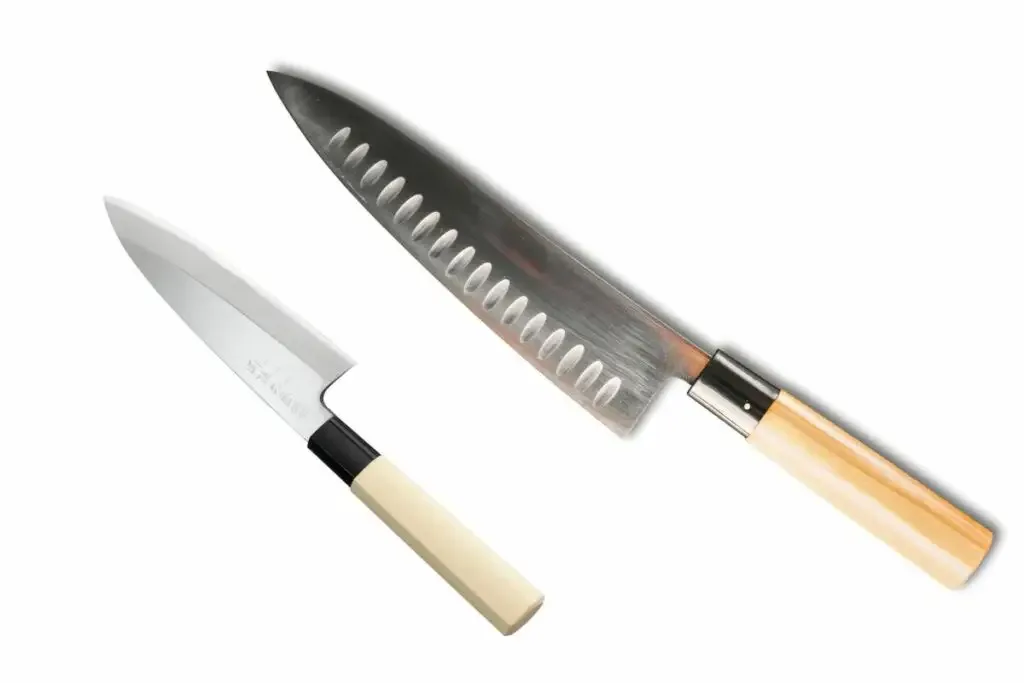As an Amazon Associate, we earn from qualifying purchases with no additional costs for you.
Knives can become an obsession for many people, and for those of us in the West, the topic of Japanese style knives is a fascinating and interesting topic. The Japanese seem to have a style of knife for every activity under the sun, and the funayuki and the gyuto are two such knives of Japanese origin. So what are the essential differences that set these two knives apart from each other?
5 essential differences between gyuto and funayuki knives:
- Size. The gyuto is larger.
- Blade profile. Gyuto has a gentle curve, funayuki is a flat blade.
- Blade bevel. Gyuto is double, funayuki is single.
- Purpose. Gyuto for meat, funayuki for fish.
- Handle style. Funayuki is more traditional.
The Japanese are people who have an attention to detail, and everything must be designed with a purpose. This has resulted in a people and a culture that has a different knife shape and design for various activities, both in the kitchen and in general day-to-day life. The Gyuto style knife and the funayuki knife are two such knives that have different designs and purposes.
If you are interested in checking out the best Japanese knives (made by Hayate Yoshihiro) we recommend and use you can find them by clicking here (Amazon link).
Funayuki Knives Vs. Gyuto Knives

Even though the funayuki and gyuto knife designs both originate in Japan, the intention of each style of knife is quite different.
These two knives look fairly similar in design at a quick glance, but they have different original applications. The difference in purpose for the knives leads to differences in blade size and geometry, and handle design.
These differences give the knives strong points in some tasks and weaknesses in others. Even though both knives are considered to be multipurpose, if you had both knives at your disposal, you would reach for the most suitable depending on the task at hand.
Origins Of The Funayuki Knife

Traditionally, the funayuki knife was a working knife that Japanese fishermen took with them aboard their fishing vessels. When translated, the name actually means “to take on a boat,” and as such, the style of knife was by necessity a multipurpose knife.
The blade needed to be robust to handle tasks on the boat and well as to process the catch. The knife was put to use to clean and fillet fish from their catch to test quality. The same knife was used in the preparation of food for the fishermen aboard the boat.
This means that the knife needed to have qualities to allow it to clean and cut fish as well as work in the kitchen to clean and chop vegetables and other general cooking tasks.
The modern funayuki knife is a lightweight, relatively short knife that is intended to be a multipurpose blade that can process small to medium-sized fish and poultry and well as smaller chopping and slicing tasks.
The lightweight nature of the blade allows it to be very sharp and, thus, it makes a good slicing knife for softer vegetables.
It is robust enough to do light chopping work, and at a push, could be used to process a chicken carcass, but the gyuto would definitely be more efficient at this type of task.
If you are interested in buying a high-quality Funayuki knife we recommend checking out this knife made by the Yoshihiro company (Amazon link).
Origins Of The Gyuto Knife

The gyuto is the Japanese version of a kitchen chef’s knife. It is designed to be the go-to knife for a chef in the kitchen and thus capable of many food processing tasks in the kitchen.
The name gyuto, when translated literally, means “beef sword,” which gives a little insight into the original intention for the knife.
It needs to have the weight and sharpness to be able to cut meat as well as perform more delicate cutting and chopping tasks in the kitchen.
This knife is a relatively longer knife to allow for leverage, but the blade is lightweight enough for finer tasks. This is a robust blade that is capable of not only slicing large cuts of meat but also separating joints in these large cuts of meat.
They are also more adept at processing poultry carcasses such as chicken and also the larger task of the turkey.
The longer blade and a bit more weight behind it give the additional leverage to be able to put your weight behind the blade to get through tougher food items.
This gives it that advantage over the funayuki blades, which are generally lighter and smaller and is not capable of pushing through joints and small bones.
If you are interested in buying a high-quality Gyuto knife we recommend checking out this knife made by the Yoshihiro company (Amazon link).
TIP: Buying Japanese knives can be expensive. But have you ever wondered if Japanese knives are cheaper in Japan? Find out a complete breakdown on pricing for Japanese knives in Japan in the article below:
Are Japanese Knives Cheaper In Japan? Complete Breakdown
5 Essential Differences Between Funayuki And Gyuto
At first glance, a gyuto knife looks like a larger version of a funayuki knife, but there are several subtle differences that set these knives apart from each other.
| Characteristic | Gyuto | Funayuki |
|---|---|---|
| Size | 8-inches to 10.5-inches. The height of the gyuto blade at the heel is about 2-inches. | 4.7-inches to 7.6-inches. The height of the funayuki blade at the heel is about 2-inches. |
| Blade profile | Gentle slope from the heel of the blade to the tip. The blade is flat for about one-third of the length and then curves toward the tip, with the most prominent part of the belly closer to the tip. | Flat blade profile with little to no curve belly on the knife. |
| Blade bevel | Double bevel. The bevel on the gyuto blade is a double bevel, with both bevels meeting at the sharp edge of the blade. | Traditionally a single bevel. The funayuki is a single bevel blade, with one side of the blade being flat and the other having the sloping bevel to the sharp edge. Western versions sometimes have double bevels. |
| Purpose | Mainly designed as a meat cutting knife but can chop vegetables at the heel with a rocking motion where the tip of the knife is always in contact with the cutting surface. The knife is often used in the kitchen as a multipurpose knife, with the focus being on cutting meat. | Mainly designed to process fish; thus, the blade is thinner. Vegetables can be chopped with an up and down motion of the bade, but the tip of the blade is usually not rested on the cutting surface. |
| Handle | The handle on the gyuto can be a western-style chef knife handle or the traditional octagonal shape, in which case the name is prefixed with “wa” as in wa-gyuto. | The handle on the funayuki knife is normally a rounded handle, with the handle being thinner towards the blade and thickening out towards the end of the handle. It is sometimes made with the traditional Japanese octagonal handle shape. |
BTW: If you want to know more about Japanese and other knives and their sharpening, check out the books listed above. These books are recommended by professional sharpeners and knife makers (Amazon links):
- Japanese Kitchen Knives: Essential Techniques and Recipes
- The Knifenerd Guide to Japanese Knives
- Knife: The Culture, Craft, and Cult of the Cook’s Knife
- Sharp: The Definitive Introduction to Knives, Sharpening, and Cutting Techniques, with Recipes from Great Chefs
Modern Takes On Traditional Japanese Knives
With the proliferation of knifemakers and the popularity of the hobby in many areas of the world. Many of these modern knifemakers borrow characteristics from the traditional Japanese knife designs and add their own design aspects to the knife.
While there is no problem with adding a knifemaker adding their own flair to a knife design, the problem is still naming the knife after the original Japanese knife that inspired the design.
This has led to some of the lines being blurred as to what is original Japanese design and what is the modern maker’s inspiration.
This has led to a lot of confusion in the knifemaking world on the exact dimensions and characteristics of these knives.
As a result, a number of publications have come on the market which details the actual historical details about the origins of these Japanese designed knives, and you can use books or publications such as this to get accurate measurements and design features for these knives should you wish to try making one yourself.
TIP: A lot of people are interested in more comparisons than just the comparison of funayuki vs. gyuto. The funayuki knife is often compared with the santoku knife. Check out the essential differences between santoku and funayuki knives in the article below:
Santoku vs. Funayuki: Six Main Differences You Should Know
How To Choose Between A Funayuki And Gyuto

Choosing between a Funayuki and a Gyuto knife can be a challenging task, especially if you’re new to Japanese knives. Both knives have their unique strengths and are designed for specific tasks in the kitchen. Here are some factors to consider when deciding between a Funayuki and a Gyuto:
- Your Kitchen Knife Needs. The first thing to consider is what you’ll be using the knife for. If you frequently prepare fish and need a knife for precise, delicate cuts, a Funayuki might be the better choice. On the other hand, if you often handle larger cuts of meat and need a versatile knife for various kitchen tasks, a Gyuto might be more suitable.
- Your Knife Skill Level. Both Funayuki and Gyuto knives require a certain level of skill to use effectively. However, the Gyuto, with its versatile design, might be more forgiving for beginners. The Funayuki, with its specific design for fish preparation, might be better suited for more experienced cooks or those familiar with Japanese cuisine.
- Your Knife Budget. Japanese knives can range significantly in price depending on the brand, craftsmanship, and materials used. Consider your budget and compare options within your price range to find a knife that offers the best value for your needs.
- Maintenance and Care. Both Funayuki and Gyuto knives will require regular sharpening to maintain their edge. Consider how much time and effort you’re willing to put into maintaining your knife. Remember, a well-maintained knife not only performs better but also lasts longer.
- Comfort and Handling. Finally, consider how the knife feels in your hand. The best knife for you should feel comfortable and balanced. If possible, try holding and using both types of knives before making a decision.
Remember, the best knife choice is the one that fits your specific needs and preferences. Both the Funayuki and Gyuto are excellent knives that can make a valuable addition to any kitchen. Consider your cooking habits, skill level, budget, and maintenance preferences to make the best choice for your kitchen.
Conclusion
The most visible difference between the gyuto and the funayuki is the overall size difference. The gyuto is the larger knife because of its original purpose for processing large cuts of meat.
The funayuki is shorter due to it being designed as a fisherman’s knife and also makes it more versatile.
While both knives are considered to be multipurpose, the funayuki is more suitable for smaller chopping tasks. Where the gyuto does a better job is in cutting through tougher meats and also separating bones at the joints. The funayuki is just too lightweight for this type of task.
In the kitchen, these knives complement each other, and a chef would most likely have a gyuto for doing heavier duty meat processing and well as processing root vegetables and a funayuki for processing fish and softer vegetables.
TIP: German knives are one of the most popular knives around the world. But are they better than Japanese knives? Find out more in the article below:
Japanese Vs. German Knives: 9 Differences & Which Is Better
